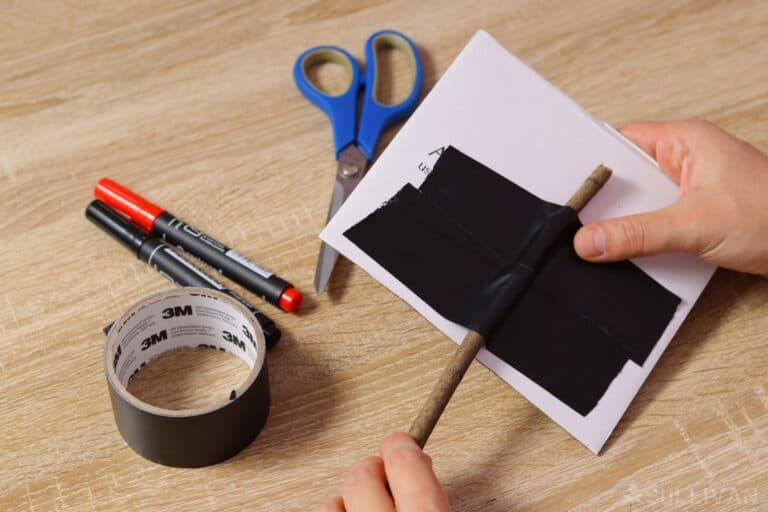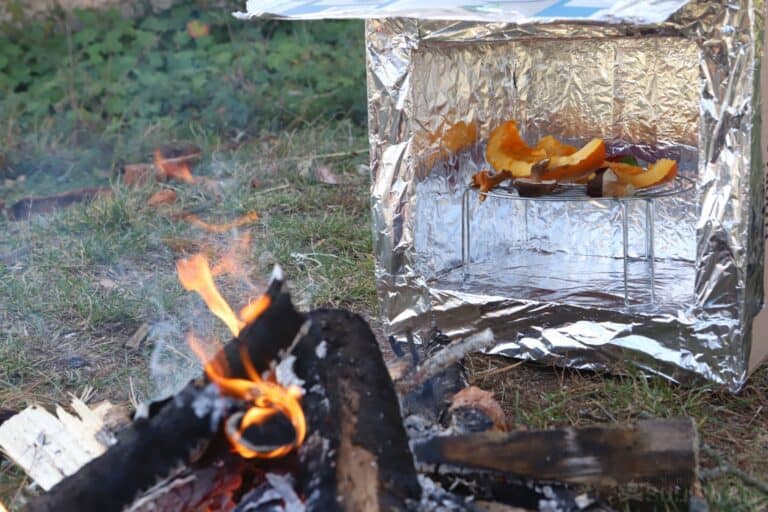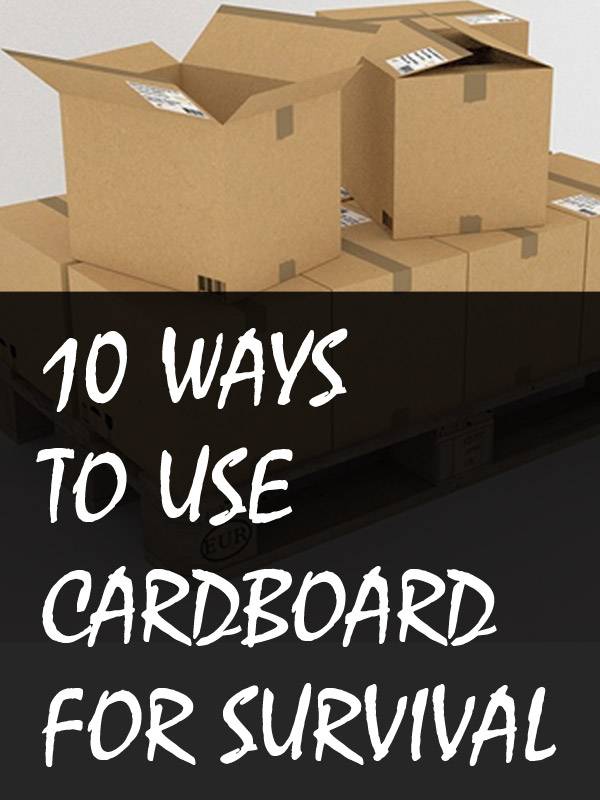When you find yourself in a survival situation, you need to have the knowledge to make use of what you can find. In the woods or a more rural environment, the resources available to you may be different than the ones you’ll find in a more urban environment.
One of the items that is easily overlooked as a survival resource is cardboard. Cardboard comes in many forms and shapes and is often readily available in an urban environment. We’ve included 10 ways to use it for survival below.
1. To Make Shelter
We’ve all seen the homeless people using cardboard boxes for shelter in the city alleyways or under bridges. In truth, when protected from direct exposure to wind and rain on either side by buildings or other structures, a cardboard box can be a temporary shelter.
This is because it’s easier to heat a small confined space than a larger space. It’s not ideal of course, and only works for survival if you have cardboard available around you, but it’s better than nothing.
If you have duct tape or other adhesive available, use it to tape the cardboard into a triangular A-frame shelter or a rectangular shape. Leave one side of cardboard against the ground if at all possible.
Once you crawl inside, the heat of your body will keep the shelter as much as 20-30 degrees warmer if you’ve insulated well enough. Use any other materials you can find, such as plastic bags over the top to protect from rain and newspaper or Styrofoam taped on the inside to further insulate.
2. To Insulate Against Cold or Trap Heat
If you find yourself stranded in an urban survival situation, and you have a small tarp to make a tent, several layers of cardboard between you and the cold ground can save you from experiencing hypothermia overnight.
If you are in your home but without heat, following an EMP or another SHTF event that knocks out power, you can use cardboard to block drafts around windows and doors. You can also use cardboard boxes or large pieces of cardboard to trap heat within a smaller area of your home. It’s easier to keep a small confined area warm than a large open room.
3. To Block Light
If your home still has power or you are using flashlights or candles following a SHTF event, you won’t want to advertise your location.
There may be lots of people looking for houses with supplies and with the power out, any light will serve as a beacon in the dark. Use cardboard on the windows to block the light from those looters passing by so you avoid becoming a target.
4. To Make a Candle or Survival Burner
Coil strips of cardboard into a sturdy round metal tin. Pour melted candle wax over the strips of cardboard. Insert a wick to make a candle. You can also use metal C clips pushed in between the cardboard strips to create a resting place for a stainless-steel cup or tin which turns your candle into a survival burner.
When lit, you’ll have a small heat source which should burn long enough to heat and purify water.
5. Make a Sign

If you get into trouble on the side of the highway nowadays, there’s no guarantee that people will stop. Even good people hesitate to get involved for fear of “butting in”.
If you need help, you can use a piece of cardboard to make a sign that says “please call police”. Put the sign in the rear window of your car to encourage passing motorists to do what they can to help.
6. Make a Meat Smoker
Following a SHTF situation that knocks out power, you may have a fridge or freezer full of food. How can you preserve that food, so you can use it to survive over the coming weeks? Use a large box about 4-foot-tall by 2 feet wide to build your own temporary meat smoker so you can smoke the meat and extend its shelf life.
Obviously, a cardboard meat smoker is not ideal, but it can be done if you are prepared in advance. Cut a hole in the bottom of one side so you can load your wood chips. You’ll need to have a heat source that can be controlled as well as the wood chips in a cast iron pan.
Push two parallel rods through the box at about one foot high and three feet high. The top rack will hold your food and bottom rack will hold a pan to catch any drippings. Monitor temperature, smoke time, and your heat source carefully to avoid any problems.
7. Make a Cardboard Oven

During an extended hike or bug out or an extended survival situation, you may need to find an alternate way of cooking your food. Cooking over an open fire is great but what if you want to bake something?
Believe it or not, you can make an oven out of a cardboard box, some heavy-duty tin foil, and a few other common items.
8. Noise Reduction for a Room
Believe it or not, cardboard can be used to help soundproof a room or for noise reduction. Following a SHTF situation, one of the most effective strategies for survival will be to stay hidden and keep quiet to avoid confrontation from intruders or looters.
You can use various forms of cardboard attached to the walls of a room to soundproof it or at least reduce the amount of noise that can be heard outside of the room.
9. Use to Eat Off Of
If you find yourself in a bug out situation or survival situations, chances are you won’t have your dishes from home with you. In a pinch though, you can cut squares of cardboard to use as plates.
You can also cut meat from the spit over a fire and lay it on a piece of cardboard to cool. Obviously, it’s not the best solution but it’s better than trying to handle hot food with your bare hands.
10. Burn It
In a survival situation, the ability to build a fire and get warm can be critical. If you find yourself in need of tinder in an urban situation, traditional wood tinder may be tough to find. But if you have cardboard available, you can use a cheese grater to make great tinder.
Any type of cardboard will work, including recycle paper drink holders you get from fast food places, cardboard boxes, cardboard/paper egg cartons, etc. It’s a good idea to wear a mask or bandana over your nose and mouth to keep from inhaling the shavings. If you don’t have a cheese grater in your bug out bag, you can cut or tear the cardboard into strips to burn it also.
Have you tried any of these ways to use cardboard when you’ve been in a survival situation? How did it go? What other ways to use cardboard for survival have you heard about? Share your experiences in the comments below.


Born and raised in NE Ohio, with early memories that include grandpa teaching her to bait a hook and watching her mom, aunts, and grandmothers garden, sew, and can food, Megan is a true farm girl at heart.
For Megan, the 2003 blackout, the events of 911, and the increasing frequency of natural disasters like Hurricane Katrina, spurred a desire to be more prepared. Soon to be living off-grid, this mother of four and grandmother of ten is learning everything she can about preparedness, survival, and homesteading.

Megan, keep it coming.I was always half ass. Prepared. But I learned a lot from you.Thank you!
My dad was in his late teens during the depression, out on his own. He told me about cutting out insoles from cardboard to put in his shoes because they had holes in the bottoms. As a little girl that story always made me want to cry.
I get so tired of seeing the same topics all the time. It’s nice to see a useful article that addresses something different. Thank you.
A variation of the cardboard sleeping box in #2 would be to build a fire-less cooker from the cardboard. These were also called hay boxes.
I’m not too sure about idea #3 – if the situation is so dangerous that windows need to get blocked, I’d suggest restricting any lighting to interior rooms without windows.
Cardboard plates? Paper plates are inexpensive, store forever when kept dry and cool and away from varmints, and could be used atop ordinary china to avoid having to wash the latter. With a pair of scissors one of these could also be instantly turned into a clean paper cup.
when I am pouring candles I use a piece of cardboard on the counter to keep everything clean. It generally ends up be wax coated and if I have and left over wax I soak small pieces of cardboard in it to make fire starters. Waxed cardboard can be water proof and can hold water (remember the old paper milk cartons – yes I am old)
Good article. If making a shelter and I had styrofoam, I would put it outside, not inside the cardboard for the simple reason that styrofoam is waterproof. The insulating qualities would be unaffected by having it outside, and it won’t get crushed and broken into little pieces as it would inside.
Excellent ideas! I love reading about inexpensive solutions to problems! Thank you!!!